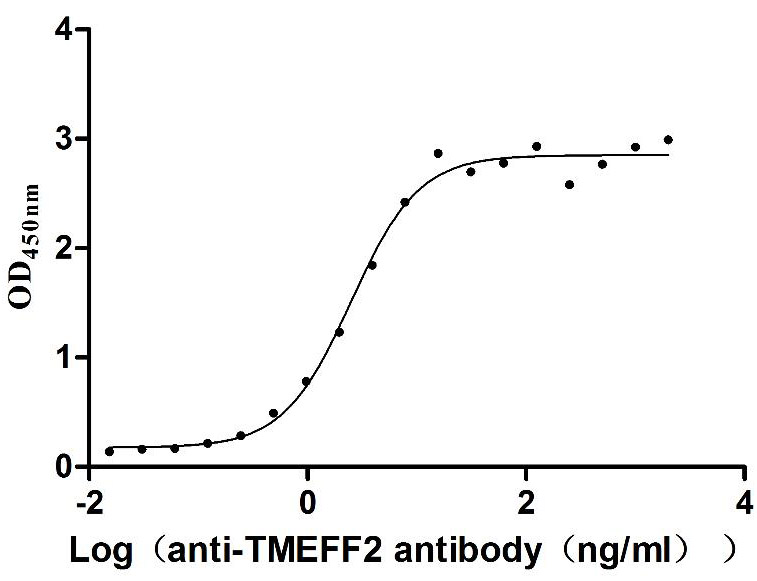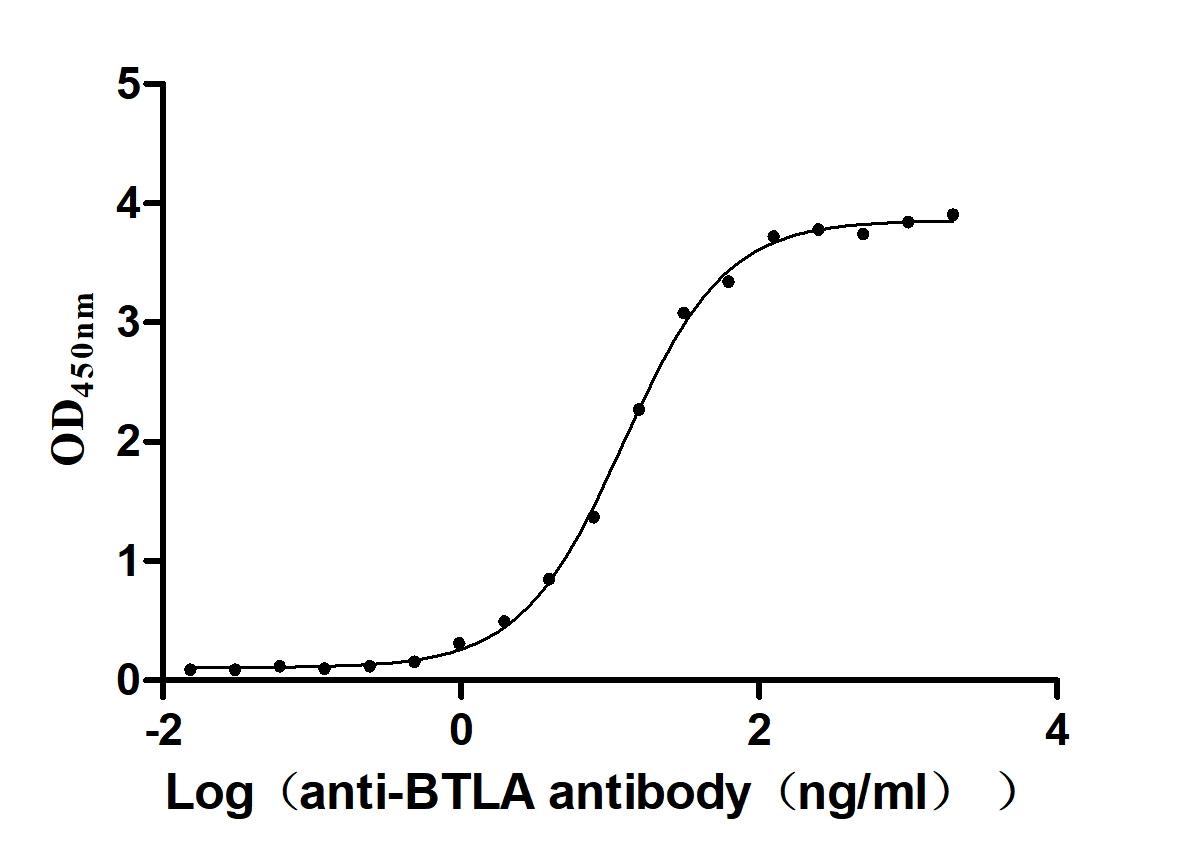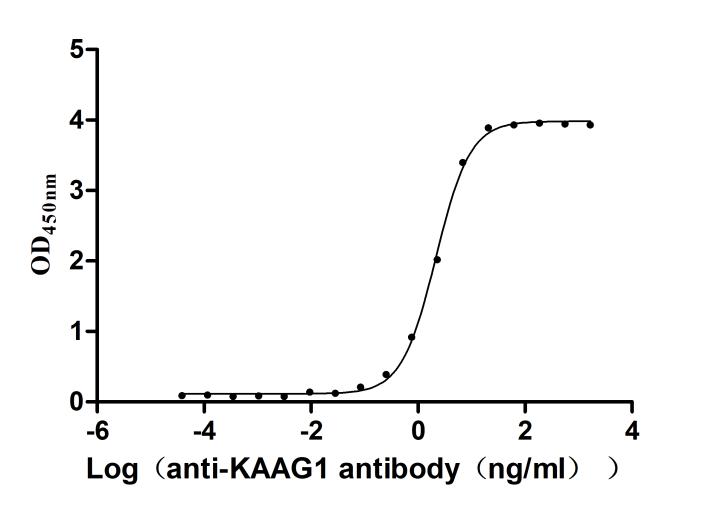Recombinant Mouse Bone morphogenetic protein receptor type-1A (Bmpr1a), partial
-
货号:CSB-YP002748MO1
-
规格:
-
来源:Yeast
-
其他:
-
货号:CSB-EP002748MO1
-
规格:
-
来源:E.coli
-
其他:
-
货号:CSB-EP002748MO1-B
-
规格:
-
来源:E.coli
-
共轭:Avi-tag Biotinylated
E. coli biotin ligase (BirA) is highly specific in covalently attaching biotin to the 15 amino acid AviTag peptide. This recombinant protein was biotinylated in vivo by AviTag-BirA technology, which method is BriA catalyzes amide linkage between the biotin and the specific lysine of the AviTag.
-
其他:
-
货号:CSB-BP002748MO1
-
规格:
-
来源:Baculovirus
-
其他:
-
货号:CSB-MP002748MO1
-
规格:
-
来源:Mammalian cell
-
其他:
产品详情
-
纯度:>85% (SDS-PAGE)
-
基因名:
-
Uniprot No.:
-
别名:Bmpr1a; Acvrlk3; Bmpr; Bone morphogenetic protein receptor type-1A; BMP type-1A receptor; BMPR-1A; Activin receptor-like kinase 3; ALK-3; BMP-2/BMP-4 receptor; Serine/threonine-protein kinase receptor R5; SKR5; CD antigen CD292
-
种属:Mus musculus (Mouse)
-
蛋白长度:Partial
-
蛋白标签:Tag type will be determined during the manufacturing process.
The tag type will be determined during production process. If you have specified tag type, please tell us and we will develop the specified tag preferentially. -
产品提供形式:Lyophilized powder
Note: We will preferentially ship the format that we have in stock, however, if you have any special requirement for the format, please remark your requirement when placing the order, we will prepare according to your demand. -
复溶:We recommend that this vial be briefly centrifuged prior to opening to bring the contents to the bottom. Please reconstitute protein in deionized sterile water to a concentration of 0.1-1.0 mg/mL.We recommend to add 5-50% of glycerol (final concentration) and aliquot for long-term storage at -20℃/-80℃. Our default final concentration of glycerol is 50%. Customers could use it as reference.
-
储存条件:Store at -20°C/-80°C upon receipt, aliquoting is necessary for mutiple use. Avoid repeated freeze-thaw cycles.
-
保质期:The shelf life is related to many factors, storage state, buffer ingredients, storage temperature and the stability of the protein itself.
Generally, the shelf life of liquid form is 6 months at -20°C/-80°C. The shelf life of lyophilized form is 12 months at -20°C/-80°C. -
货期:Delivery time may differ from different purchasing way or location, please kindly consult your local distributors for specific delivery time.Note: All of our proteins are default shipped with normal blue ice packs, if you request to ship with dry ice, please communicate with us in advance and extra fees will be charged.
-
注意事项:Repeated freezing and thawing is not recommended. Store working aliquots at 4°C for up to one week.
-
Datasheet :Please contact us to get it.
相关产品
靶点详情
-
功能:On ligand binding, forms a receptor complex consisting of two type II and two type I transmembrane serine/threonine kinases. Type II receptors phosphorylate and activate type I receptors which autophosphorylate, then bind and activate SMAD transcriptional regulators. Receptor for BMP2, BMP4, GDF5 and GDF6. Positively regulates chondrocyte differentiation through GDF5 interaction. Mediates induction of adipogenesis by GDF6.
-
基因功能参考文献:
- we generated the transgenic mouse line with deletion of Tak1 and gain of function of Bmpr1a. This compound mutation leads to more severe craniofacial deformities than each single mutation. PMID: 29411501
- Data shows that 1) hepatocyte-specific Alk3 deficiency partly protects from anemia of inflammation (AI), 2) the development of hypoferremia is partly dependent on ALK3, and 3) the ALK3/BMP/hepcidin axis may serve as a possible therapeutic target to attenuate AI. PMID: 29482530
- Bmpr1a deletion transiently disrupted development of prenatal pancreatic islets and reduced expression of E-Cadherin. PMID: 28922976
- These studies emphasize the pivotal role of BMPR1A in the determination of bone quality and mechanical integrity under physiological conditions, with different impact on femoral cortical and trabecular compartments. PMID: 27113526
- loss of BMP signaling specifically in osteocytes dramatically increases bone mass presumably through simultaneous inhibition of RANKL and SOST, leading to osteoclast inhibition and Wnt activation together. PMID: 27402532
- Data indicate the regulation of energy balance in BMPR1A-mediated appetite regulation in POMC neurons. PMID: 29040444
- findings suggest that GJA1 may be one of the downstream targets of BMPR1A signaling in osteoclasts that mediates osteoclast-osteoblast communication during bone remodeling. PMID: 27649478
- deletion of BMPR1a in oncogenic astrocytes resulted in decreased proliferation, decreased invasion, decreased migration, and increased expression of stemness markers PMID: 26683138
- different levels of expression and subsequent activation of Smad signaling differentially contribute each BMP type I receptor to BMP-Smad signaling and craniofacial development. PMID: 28641928
- BMP signaling mediated by coordination of ALK2/ACVR1, ALK3/BMPR1A, and BMPR2 is an essential proangiogenic cue for retinal vessels. PMID: 28232325
- Gonadotrope-specific Bmpr1a knockout animals developed normally and had reproductive organ weights comparable with those of controls. Knockouts were fertile, with normal serum gonadotropins and pituitary gonadotropin subunit mRNA expression. Cre-mediated recombination of the floxed Bmpr1a allele was efficient and specific, as indicated by PCR analysis of diverse tissues and isolated gonadotrope cells. PMID: 27029473
- CK2.1 peptide drives chondrogenesis and cartilage formation without induction of chondrocyte hypertrophy by releasing CK2 from distinct sites at BMPRIa PMID: 27312334
- These results suggest that Pax8 maybe the downstream molecule of ALK3, it mediates the murine heart development via cellular senescence, which may serve as a mechanism that compensates for the cell loss via apoptosis in heart development. PMID: 26781745
- Bmpr1aDeltaMES mice exhibited increased subepithelial proliferation with changes in cellular composition leading to the development of a primed stroma with modulation of extracellular matrix proteins, immune cells and cytokines as early as 90 days of age PMID: 26773796
- study suggested that Bmpr-Ia and Bmpr-Ib signaling regulates tooth formation via miR-135a. PMID: 24667771
- signaling via activin-like kinase 3 (ALK3/BMPR1A), a BMP type 1 receptor, is necessary for blastocyst attachment. PMID: 26721398
- Interactions between mechanical loading and BMP signaling through BMPR1A. PMID: 26489086
- Myo-endothelial progenitors with functioning Bmpr1a signalling demonstrate myogenic potential, but their main function in vivo is to inhibit intramuscular adipogenesis, both through a cell-autonomous and a cell-cell interaction mechanism. PMID: 24898859
- Bmpr1a is critical for the development and growth of the mandibular condyle via its effect on proliferation of prechondroblasts and chondrocyte differentiation PMID: 25158185
- BMP-Smad4 signaling is required for precartilaginous mesenchymal condensation independent of Sox9 in the mouse. PMID: 25641697
- An essential role of finely tuned BMPRIA mediated signaling in temporomandibular joint development. PMID: 25093411
- Alk3 mediated Bmp signaling is important in the cascade of events that regulate the contribution of EPDCs to the AV sulcus, annulus fibrosus, and the parietal leaflets of the AV valve PMID: 25300579
- Anti-Mullerian hormone recruits BMPR-IA in immature granulosa cells PMID: 24312319
- results provide evidence that HFE induces hepcidin expression via the BMP pathway: HFE interacts with ALK3 to stabilize ALK3 protein and increase ALK3 expression at the cell surface. PMID: 24904118
- Data indicate that epithelial-specific bone morphogenetic protein (Bmp) receptor 1a (Bmpr1a) conditional mutation leads to prostatic epithelial hyperplasia. PMID: 24731097
- Bmpr1a is involved in postnatal growth plate cell differentiation. PMID: 24163588
- FGFR3 induces degradation of Bmpr1a to regulate skeletal development. PMID: 24657641
- Data suggest BMP2 (bone morphogenetic protein 2) stimulates SMAD2/3 signaling in gonadotrophs via Bmpr1a activation; such signaling via SMAD3 appears to be necessary for up-regulation of Fshb (follicle stimulating hormone beta) transcription. PMID: 24601881
- The ability of IL-6 to induce hepatic hepcidin gene expression and reduce serum iron concentrations is dependent on the BMP type I receptor Alk3. PMID: 24501215
- BMPR1a and BMPR2 are downregulated in cardiac remodeling and heart failure PMID: 24398041
- Augmented BMPRIA-mediated BMP signaling in cranial neural crest lineage leads to cleft palate formation and delayed tooth differentiation. PMID: 23776616
- The effects of Alk3 knockout on tooth epithelial cells are dependent on the upregulation of the Wnt/beta-catenin pathway. PMID: 24081330
- BMPR1 signaling controls dendrite complexity postnatally during the major dendritic growth period of sympathetic neurons. PMID: 24048844
- This study demonistrated that BMP signaling has no major role in the development of excitatory and inhibitory synapses in the lateral superior olive. PMID: 23708139
- Perturbation of Alk3-mediated BMP signaling from the second heart field results in impaired development of the dorsal mesenchymal protrusion and ostium primum defects. PMID: 23584254
- These findings provide genetic evidence indicating that optimal Bmpr1a-mediated signaling is essential for neural crest-derived mesenchymal cell survival in both normal nasal and frontal bone development. PMID: 22773757
- These findings suggest that BMPR1A signaling is critical for postnatal establishment of leptin-responsive orexigenic fibers from ARH to multiple hypothalamic nuclei. PMID: 23197713
- ALK3 is the primary type I receptor recruited by the MIS-MISRII complex during Leydig cell differentiation. PMID: 22872577
- evidence functionally identifies BMPR1A as a potential new regulator of mammary epithelial alveolar cell differentiation PMID: 22729646
- BMPR1A fusion protein stimulates osteoblastic bone formation and decreases bone resorption, which leads to an increase in bone mass, and offers a promising unique alternative for the treatment of bone-related disorders. PMID: 22761317
- A regulatory mechanism of BMPRIa signaling at the plasma membrane of BMSCs. PMID: 22170575
- activin-like kinase 3 (Alk3) is elevated early in diseased kidneys after injury..its deletion leads to enhanced Smad3 signaling, epithelial damage and fibrosis, suggesting a protective role for Alk3-mediated signaling in the kidney PMID: 22306733
- These data suggest that in congenic 6T mice BMP receptor, including BMPR1a, aggregation is inhibited causing an inhibition of signaling and reduced bone mass. PMID: 22036911
- Mineralization was initiated with the overexpression of the BMPRIa mutants indicating CK2 is a negative regulatory protein for osteoblast differentiation PMID: 21763800
- results indicate that deletion of Bmpr1a in differentiated osteoclasts increases osteoblastic bone formation, thus suggesting that BMPR1A signaling in osteoclasts regulates coupling to osteoblasts by reducing bone-formation activity during bone remodeling PMID: 21786321
- This would be the first report showing that the mutation of the Bmpr1a gene in the bulbourethral gland (BUG) epithelia phenocopied some abnormalities of human congenital syndromes affecting the BUG duct PMID: 21848994
- Alk3, is critically responsible for basal hepcidin expression, whereas 2 type I BMP receptors, Alk2 and Alk3, are required for regulation of hepcidin gene expression in response to iron and BMP signaling. PMID: 21841161
- The results demonstrate a requirement for Alk3 in distinct progenitor cell populations derived from the intermediate mesoderm. PMID: 21613322
- JNK1 activation decreases binding of inhibitory Smad6 to the type I BMP receptor. PMID: 21542012
- A requirement for BMP signaling in patterning of dorsal neural tube cell fate and in neural crest cell formation, and a critical period shortly before neural tube closure. PMID: 21394823
显示更多
收起更多
-
亚细胞定位:Cell membrane; Single-pass type I membrane protein. Cell surface.
-
蛋白家族:Protein kinase superfamily, TKL Ser/Thr protein kinase family, TGFB receptor subfamily
-
组织特异性:Widely expressed.
-
数据库链接:
KEGG: mmu:12166
STRING: 10090.ENSMUSP00000035900
UniGene: Mm.237825
Most popular with customers
-
Recombinant Human Leukemia inhibitory factor (LIF) (Active)
Express system: Mammalian cell
Species: Homo sapiens (Human)
-
Recombinant Human Claudin-6 (CLDN6)-VLPs, Fluorescent (Active)
Express system: Mammalian cell
Species: Homo sapiens (Human)
-
Recombinant Human Tomoregulin-2 (TMEFF2), partial (Active)
Express system: Mammalian cell
Species: Homo sapiens (Human)
-
Recombinant Human Oncostatin-M (OSM), partial (Active)
Express system: Mammalian cell
Species: Homo sapiens (Human)
-
Recombinant Human B- and T-lymphocyte attenuator(BTLA), partial (Active)
Express system: Mammalian cell
Species: Homo sapiens (Human)
-
Recombinant Human Kidney-associated antigen 1(KAAG1) (Active)
Express system: E.coli
Species: Homo sapiens (Human)



f4-AC1.jpg)














